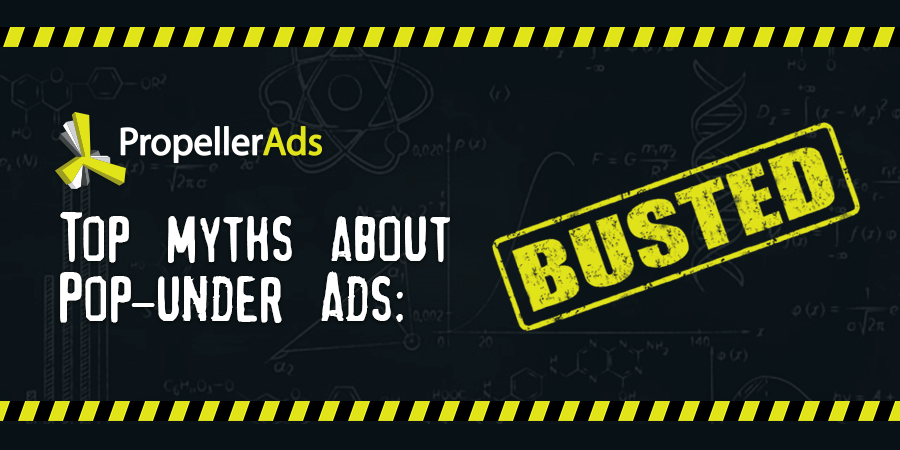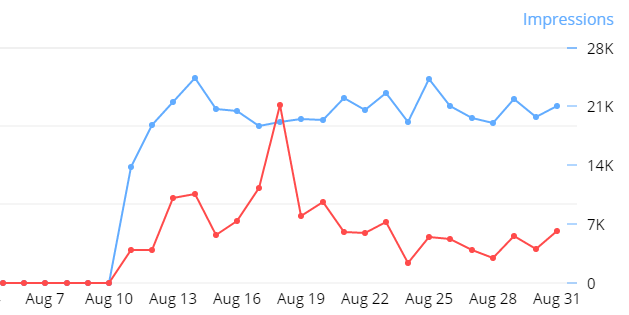Top myths about Pop-Under Ads: Busted!

Most of Propeller Ads publishers stick with Popunder ads because they generate the biggest profit among all ad units. Today we’re going to see the horrifying truth behind the good revenue.
For the majority of users, Pop-under ads are the dark horse in the world of Advertising. Every site owner secretly wants to give it a try but has already heard some scary stories about how Pop-unders hurt the user experience and cause your site to receive Google penalties.
That’s why we’ve decided to ask Propeller Ads experts to comment on top myths about Pop-under ads. Let’s hear the truth at last!
Myth #1: Websites will receive Google penalties for using Pop-unders
Kate Mit, Propeller Ads monetization consultant says:
“Pop-unders as ad units can’t harm your site’s ranking in Google. Have a look at the video from Google Webmasters official channel. Matt Cutts, (perhaps the most famous Google expert), answers the question: ‘What will be the effect of using Pop-under advertisements from a search engine ranking point of view?’ He clearly said from a search engine perspective, Pop-under ads do not make any difference.”
Myth #2: Pop-unders hurt user experience and prevent your visitors from coming back
John Mathews, Propeller Ads monetization consultant says:
“For sure people don’t like ads. This makes site owners look for ad formats that in their opinion don’t influence user experience. Therefore many publishers prefer banner ads, native ads and other ‘harmless’ units. But are they really so innocent?”
Q: Pop-under ads are annoying and hurt user experience!
“I bet you’ve seen websites where a dozen of banners are loading at a time, flashing at you, distracting you, preventing you from scrolling, and covering the entire screen. As a result, it takes ages to load the content.
Recent experiments have proven that even small widgets and social buttons can slow down your site’s loading time. Imagine what happens when a site owner decides to generate profit from display ads and places “clean” banners using Flash or other technologies for rich-media!
Another example of a “harmless” ad format is native ads (widget ads) which are sponsored material that looks like the site’s genuine content.
Often, to achieve the highest CTR (click-through rate) the ads attract the user with vulgar and strong sexual teasers that exploit natural human curiosity. Then, as the user sees the content behind the ads, his expectations are not met, so he feels fooled and disappointed. Finally, all his negative emotions become associated with the site which “tricked” him.

some popular native ads
When talking about unpleasant surprises, we can’t ignore video ads that are embedded in a site’s content. Have you ever seen those irritating autoplay videos that appear out of nowhere and scream into your ears? They are terrible, especially if you use headphones! This type of ad not only distracts visitors but also annoys them.
Or take video hosting platforms, where you are forced to see several seconds of autoplay ads with loud music almost EVERY TIME you want to watch your favorite cat video. It’s understandable that users become frustrated when they find out that there will be another pre-roll. Distracting, forcing and tricking your visitors doesn’t seem very user-friendly, do they?
Compare this to a Pop-under that opens in a separate tab only once per user session, (or even less), and doesn’t distract visitors from interacting with site’s content. What would you choose?”
Q: Sites with Pop-under ads get a higher bounce rate and lose their audience.
“Using OnclickAds as a monetization solution can’t seriously harm your site’s reputation if it contains exciting content and the ads are well-adjusted. Based on a webglide.com experiment measuring bounce rates with and without a Pop-under, most of the visitors don’t mind the Pop-under and continue surfing the site. So reality proves that most publishers’ worries are far exaggerated. See one of our partners’ statistics before and after placing the OnclickAds tag:

amount of pageviews after popunder ads placement is not dropped
As you can see the number of sessions has hardly changed so there was no traffic drop after ads were integrated.”
Myth #3: Visitors will get malware through Pop-unders
Anna Lars, Propeller Ads monetization consultant says:
“The origin of malware is neither the ad format nor the network you are working with. To be exact, it’s certain advertisers who violate the Network’s Policy Terms.
Malware is a common problem of the entire online advertising market. Even the industry leaders are not protected from the unintentional spreading of malicious code.
For our part, Propeller Ads use several malware protection technologies simultaneously to secure our system and to prevent any policy violation or fraud.
All the campaigns and connected creatives go through hand moderation, and our Policy Team immediately terminates any suspicious activity, not only by registration but also during the complete working period.
As to any unwanted advertising, publishers can disconnect any suspicious campaigns from their sites, simply by contacting his/her personal manager or support team.”
Myth #4: You can’t use Pop-unders if you’re already using AdSense
Anna Lars, Propeller Ads monetization consultant says:
“A lot of our publishers use OnclickAds Pop-under and AdSense on the same site. The results are great as by combining these two types of ads they literally double their profit.
As to the widespread opinion that it is prohibited to use Pop-unders on the same page as Google Ads: it’s absolutely false.
Google’s Ad Placement Policy clearly says:
“Publishers are not permitted to place Google ads on sites which have more than three pop-ups. If pop-ups are displayed on a site, they may not interfere with site navigation, change user preferences, initiate downloads, or distribute viruses.” See full Policy text here
The only thing you cannot do is integrate AdSense into any window that is not initiated by a user’s click. To cut a long story short: you can’t paste AdSense ad units into a Pop-under. It would be a strange thing to do, right? :)”
Myth #5: Pop-unders are only good for porn or low-quality sites because top brands won’t work with such kind of ads
Helen Rivers, Propeller Ads monetization consultant says:
“Let me remind you that Pop-under/Pop-up ads have been widely used on the websites of international companies and well-known brands that obviously care much more about their reputation.
With Pop-unders it’s all about quality and settings. For example, one of the companies from the traveling niche used Pop-unders to present relevant accommodation offers from their partners. So if ads are contextual, and ad units appear just when the user might need then, it won’t hurt the brand’s reputation. In addition, it might bring the site’s owner significant profit as highly targeted ads are the most effective today.
Meanwhile, some publishers still consider Pop-unders to be a cheap alternative to ‘real’ advertising and worry about their visitors seeing promotion as poor quality or even fraudulent products.
But I can assure you that our team is constantly working on bringing the best international brands to our Ad Network. And you can always turn off any offer that may seem inappropriate or irrelevant to you.”
Conclusion
We hope to have dispelled all the scary myths about Pop-under Ads and encouraged you to give them a try on your site.
Here’s a final bit of advice about using Pop-under Ads: they can be integrated with all kinds of sites. Though, based on our experience, the golden formula is a good content site with a portion of search engine traffic. In this case, your users won’t feel any negative impact from Onclick Ads.
If you feel ready for a test – login to your publisher’s account or register if you don’t have one. Get the tag and make your site a real moneymaker!
Happy monetizing!
Contact us if you have any questions or want to share your experience.
